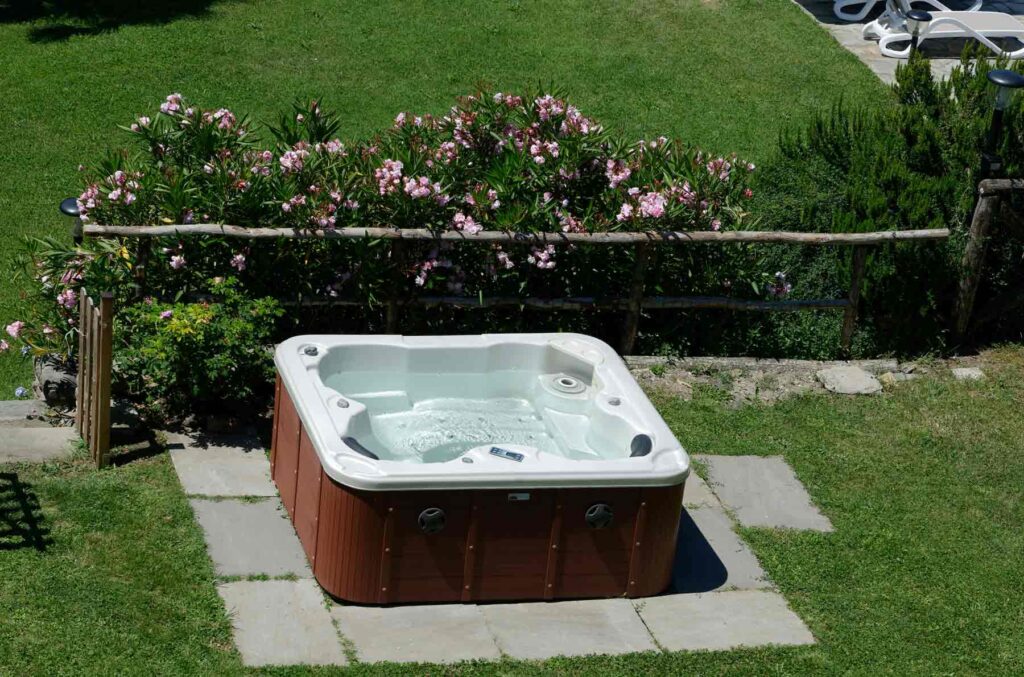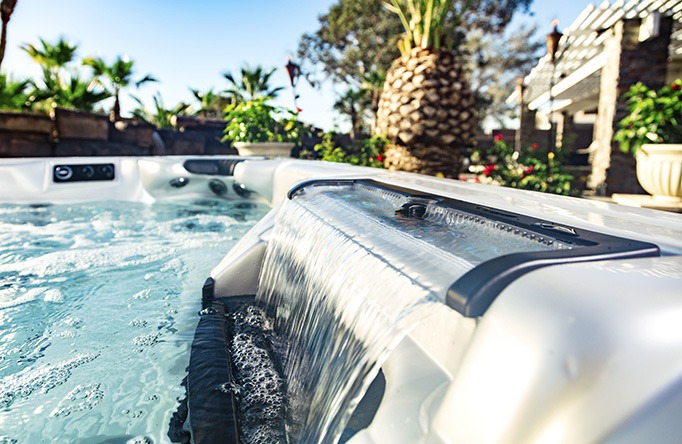Buying a spa can be an exciting and rewarding investment, but it’s essential to carefully consider your options before purchasing. With so many models and features available, it can be challenging to know where to start.
In this article, we’ll discuss some key factors to consider when buying a spa. These factors we hope will help you make an informed decision.
1. Size and Capacity
The size and capacity of a spa have several factors to consider to ensure an enjoyable and comfortable experience.
The first aspect to consider is the number of people who regularly use the spa.
- User Capacity: A two-—to three-person spa may be perfect for couples or individuals. A larger model that fits 6-8 people will provide more comfort for families or those who enjoy hosting.
- Space Considerations: Measure the area where you plan to install the spa. Ensure you leave enough room for easy access and additional features like steps or decking.
- Seating and Comfort: Explore different seating arrangements and jet placements to ensure the spa meets your preferences for relaxation and hydrotherapy.
By carefully evaluating the size and capacity, you’ll select a spa that provides a perfect balance of comfort and space.
2. Features and Accessories
When purchasing a spa, it’s crucial to consider the features and accessories that will enhance your overall hot tub experience.
- Jets: Consider the type and number of jets. Adjustable jets allow you to target specific muscle groups and customize your massage experience.
- Heating System: Look for energy-efficient heating systems that maintain water temperature while keeping costs low.
- Filtration: Choose a spa with a reliable filtration system to ensure clean, clear water. Options like UV or ozone purification can help maintain water quality with less effort.
- Additional Accessories: For an enhanced experience, explore LED lighting, built-in sound systems, or even waterfalls to create the ultimate spa ambiance.
Don’t forget to consider safety features like cover locks, child-proof settings, or safety rails if needed.
Prioritizing the features and accessories that align with your preferences and desired comfort level will ensure an optimal experience.
3. Energy Efficiency
Energy efficiency is a critical consideration when choosing a spa. An energy-efficient spa will lower your electricity bill and reduce your environmental impact.
- Insulation: High-quality insulation, such as foam or thermal barriers, helps retain heat and minimizes energy loss.
- Pumps and Motors: Opt for variable-speed pumps, which allow you to adjust the water flow, saving energy when full power isn’t necessary.
- Programmable Controls: Look for spas with timers and programmable settings to avoid heating when the spa is not in use.
- Spa Covers: A well-insulated cover can prevent heat loss and reduce evaporation, further lowering energy costs.
By carefully considering these energy-efficient features. You can choose a spa that provides relaxation and enjoyment. It will help you save on energy costs and contributes to a greener environment.
4. Maintenance and Upkeep
- Water Chemistry: To keep the water safe and comfortable, regularly test it for pH, alkalinity, and sanitizer levels.
- Filtration: Clean the filters regularly and ensure proper water circulation to avoid debris buildup.
- Surface Cleaning: Use non-abrasive cleaners to wipe down the spa’s shell, jets, and other surfaces.
- Cover Care: Keep your spa cover clean and inspect it for wear and tear to ensure it continues to provide insulation and protection.
It is important to monitor the spa’s mechanical components, such as pumps, heaters, and controls. Regularly inspect for leaks, unusual noises, or malfunctions, and promptly address any issues by contacting a qualified technician.
Follow these maintenance practices to keep your spa or hot tub in excellent condition. This will prolong its lifespan and make it safe and enjoyable for years. We also have free downloadable guides to help maintain your hot tub.
5. Price and Budget
- Initial Cost: Spa prices vary based on size, brand, and features. Set a realistic budget that reflects your financial situation and desired features.
- Operating Costs: These are factors in ongoing expenses like electricity, water maintenance products, and occasional repairs. Energy-efficient models may cost more upfront but will save you money over time.
- Prioritizing Features: Determine which features are essential and which can be added later, allowing you to stay within your budget.
Setting a budget early on will help you make a purchase that meets your needs without overspending.
6. Brand Reputation and Warranty
When buying a spa, brand reputation and warranty are critical factors that can make a big difference in your purchase’s long-term value. A reputable brand not only ensures product quality but also provides reliable customer service and support.
- Brand Reputation: Research different spa manufacturers to find those with a solid track record of producing high-quality products. Look for brands known for durability, performance, and customer satisfaction. Reading online reviews and testimonials can help gauge how other customers feel about the brand’s products and services. Established brands with a proven history of reliability are more likely to meet your expectations and provide a worry-free ownership experience.
Warranty Coverage: A comprehensive warranty is necessary when investing in a spa. It offers protection against manufacturing defects and potential issues down the road. Pay attention to the length and scope of the warranty—most quality spas will offer a multi-year warranty that covers critical components like pumps, heaters, and jets. Some warranties also cover labor and service fees, providing additional peace of mind. Ensure the warranty includes specific conditions, such as routine maintenance or professional installation, that you need to follow to keep it valid.
Terms and Conditions: Carefully read the warranty terms to understand what is covered and what exclusions may apply. Some warranties cover major components for longer periods while only offering limited coverage for other parts like the spa shell or control systems. Understanding the warranty details will help avoid surprises if you need repairs or service.
You can make a more informed decision by considering the brand’s reputation and understanding the warranty coverage in detail. Choose a spa from a trusted brand that stands behind its products, ensuring you receive a high-quality, long-lasting spa that delivers years of enjoyment and relaxation.
7. Location and Installation
Before purchasing a spa, carefully consider the location where it will be placed. Choosing the right spot is crucial for both practical and aesthetic reasons.
- Space and Accessibility: Make sure the spa fits comfortably in the designated area, with enough room for access, maintenance, and additional features like steps.
- Surface: The spa should be placed on a sturdy, level surface like a concrete pad or reinforced deck.
- Environment: Consider privacy, views, and exposure to the elements. A sheltered, sunny location can enhance your spa experience, especially in cooler months.

Proper installation is crucial for both the functionality and appearance of your spa.
8. Safety and Accessibility
Considering the safety features of a spa is of utmost importance when making a purchase. You want to ensure a secure and worry-free experience.
- Cover Locks: A sturdy, locking cover is vital for preventing unauthorized access, particularly if you have children or pets. A cover that securely fastens can also support weight, offering additional protection and preventing accidents when the spa is not in use. For more information on hot tub covers, read our article “Why Are Hot Tub Covers Important?”
Safety Rails and Grab Bars: Installing grab bars or safety rails provides stability when entering and exiting the hot tub. This is especially important to reduce the risk of slips or falls. Additionally, look for spas with non-slip surfaces, such as textured floors or seats, which enhance traction and further minimize the chances of slipping.
Built-In Safety Features: Many modern spas come with built-in safety mechanisms, such as automatic shut-off timers for the jets, lights, and heating system. These features prevent overheating and excessive energy consumption by turning off the spa after a set period.
Safety Certifications: It’s also wise to ensure the spa meets industry safety standards. Look for certifications like UL (Underwriters Laboratories) or CE (Conformité Européenne), which indicate that the spa has undergone rigorous safety testing and complies with recognized safety regulations.
When you carefully consider these safety features while purchasing a spa or hot tub, you can place the well-being of yourself, your family, and your guests as a top priority. Doing so creates a serene and secure environment where everyone can enjoy a relaxing experience without any concerns for their safety.
9. Personal Preferences and Lifestyle
Frequently Asked Questions (FAQs) About Buying a Spa
Before installing a spa, you’ll need to prepare a level, solid surface to support the weight of the filled spa. Common options include a reinforced deck, concrete pad, or a specially designed spa base. Additionally, ensure enough space around the spa for maintenance access and proper ventilation. It’s also important to plan for electrical connections and a water source nearby for filling and draining the spa.
Maintenance costs vary depending on the size and features of your spa. On average, you should expect to spend $300-$500 per year on water treatments, cleaning supplies, and electricity. Energy-efficient models and regular maintenance can help lower costs over time.
Look for spas with high-quality insulation (such as foam insulation), energy-efficient pumps and motors, and programmable heating systems. A well-insulated spa cover also helps retain heat and reduce energy consumption.
Regular maintenance is essential to keep your spa clean and safe. You should clean the filter every 2-4 weeks, wipe down the surfaces, and test the water chemistry weekly. Additionally, drain and refill the spa every 3-4 months to maintain water quality.
While the terms are often used interchangeably, a “hot tub” typically refers to a freestanding tub with heated water, while a “spa” may refer to either an in-ground or above-ground setup that offers various hydrotherapy features. Both provide similar relaxation benefits.
For more details, check out our article “Understanding the Differences Between Spas, Hot Tubs, Jacuzzis, and Whirlpools.”
Research the brand’s reputation by reading online reviews, checking customer testimonials, and reviewing its length of business. Brands with established histories of quality manufacturing and customer service are usually more reliable.
Most reputable spa brands offer warranties, but coverage can vary. Look for warranties that cover essential components like pumps, heaters, jets, and labor for repairs. Be sure to read the terms and conditions of the warranty to understand what’s covered and any required maintenance to keep the warranty valid.
Yes, but it’s important to ensure that your deck is strong enough to support the weight of the filled spa, which can weigh thousands of pounds. You may need to consult a professional to evaluate your deck’s structure and, if necessary, reinforce it.
Key safety features include locking covers to prevent unauthorized access, safety rails or grab bars for stability, non-slip surfaces, and built-in automatic shut-off systems. These features ensure a safe and worry-free spa experience.
With proper maintenance, most spas last 10-20 years. However, factors like the quality of materials, regular upkeep, and the manufacturer’s warranty can affect the lifespan of your spa.
For More details, check out our article “How Many Years Will a New Hot Tub Last?”

